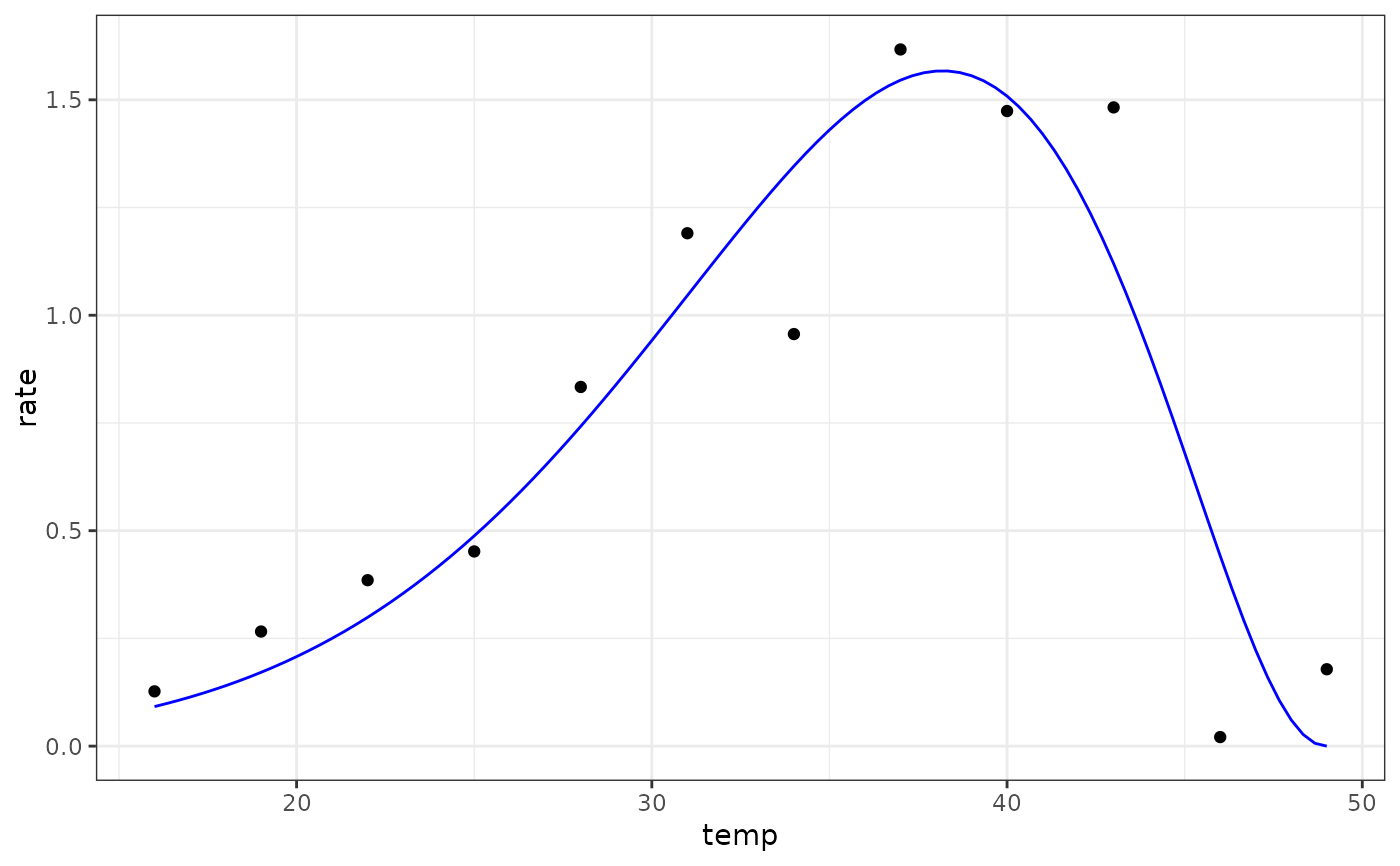flexTPC model for fitting thermal performance curves
Arguments
- temp
temperature in degrees centigrade
- tmin
low temperature (ºC) at which rates become negative
- tmax
high temperature (ºC) at which rates become negative
- rmax
maximum performance/value of the trait
- alpha
shape parameter to adjust the asymmetry and direction of skew of the curve
- beta
shape parameter to adjust the breadth of the curve
Value
a numeric vector of rate values based on the temperatures and parameter values provided to the function
Details
Equation: $$rate=r_{\text{max}}\left[\left(\frac{T - T_{\text{min}}}{\alpha}\right)^\alpha\left(\frac{T_{\text{max}}-T}{1-\alpha}\right)^{1-\alpha}\left(\frac{1}{T_{\text{max}}-T_{\text{min}}}\right)\right]^{\frac{\alpha(1-\alpha)}{\beta^2}}$$
Start values in get_start_vals are derived from the data or sensible values from the literature.
Limits in get_lower_lims and get_upper_lims are derived from the data or based extreme values that are unlikely to occur in ecological settings.
References
Cruz-Loya M, Mordecai EA, Savage VM. A flexible model for thermal performance curves. bioRxiv [Preprint]. 2024
Examples
# load in ggplot
library(ggplot2)
# subset for the first TPC curve
data('chlorella_tpc')
d <- subset(chlorella_tpc, curve_id == 1)
# get start values and fit model
start_vals <- get_start_vals(d$temp, d$rate, model_name = 'flextpc_2024')
# fit model
mod <- nls.multstart::nls_multstart(rate~flextpc_2024(temp = temp, tmin, tmax, rmax, alpha, beta),
data = d,
iter = c(5,5,5,5,5),
start_lower = start_vals - 10,
start_upper = start_vals + 10,
lower = get_lower_lims(d$temp, d$rate, model_name = 'flextpc_2024'),
upper = get_upper_lims(d$temp, d$rate, model_name = 'flextpc_2024'),
supp_errors = 'Y',
convergence_count = FALSE)
# look at model fit
summary(mod)
#>
#> Formula: rate ~ flextpc_2024(temp = temp, tmin, tmax, rmax, alpha, beta)
#>
#> Parameters:
#> Estimate Std. Error t value Pr(>|t|)
#> tmin -9.2463 157.0209 -0.059 0.954689
#> tmax 49.0000 10.0356 4.883 0.001788 **
#> rmax 1.5386 0.2002 7.686 0.000118 ***
#> alpha 0.8077 0.4131 1.955 0.091478 .
#> beta 0.1239 0.3873 0.320 0.758420
#> ---
#> Signif. codes: 0 ‘***’ 0.001 ‘**’ 0.01 ‘*’ 0.05 ‘.’ 0.1 ‘ ’ 1
#>
#> Residual standard error: 0.2895 on 7 degrees of freedom
#>
#> Number of iterations to convergence: 58
#> Achieved convergence tolerance: 1.49e-08
#>
# get predictions
preds <- data.frame(temp = seq(min(d$temp), max(d$temp), length.out = 100))
preds <- broom::augment(mod, newdata = preds)
# plot
ggplot(preds) +
geom_point(aes(temp, rate), d) +
geom_line(aes(temp, .fitted), col = 'blue') +
theme_bw()

